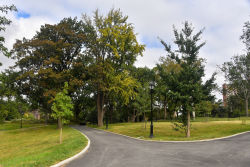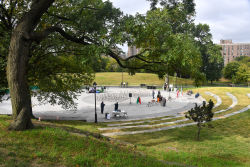St. Mary's Park
St. Mary’s Recreation Center
St. Mary’s Recreation Center was the first indoor recreation facility to open in New York City. After World War II, Parks Commissioner Robert Moses (1888-1981) inaugurated a city-wide recreation program to provide the most congested city neighborhoods with places to play and socialize in cold weather months. Opened within St. Mary’s Park in 1951, this facility served as the pilot project for eight other centers. Moses believed that the centers would occupy the children of the city during the winter, keeping them from activities that he characterized as “undesirable.” The areas in which Commissioner Moses chose to place the Centers were neighborhoods that he saw as suffering from severe juvenile delinquency problems, located in Manhattan, Brooklyn, the Bronx, and Queens.
Designed by the architectural firm of Brown, Lawford, and Forbes, St. Mary’s Recreation Center housed an indoor swimming pool, gymnasium, locker and shower rooms, and meeting rooms for classes and community programs. The City provided $967,500 for the project. Immediately following the opening of the center on March 30, 1951, a riot occurred when an overflow of local youths could not get into the building. The Recreation Center was pelted with stones causing $1,000 in damage to the windows. In response to the vandalism, Commissioner Moses announced an increase in the membership fee for the facility. Initially, a membership card for St. Mary’s cost ten cents, but Moses stated that Parks could not meet the costs of both operation and vandalism and consequently raised the fee to 20 cents per card.
St. Mary’s Park, one of the six original parks in the Bronx, spans the history of the borough from the colonial era to modern development. The park site was once part of the estate of early settler Jonas Bronck (1600-43), for whom the Bronx is named. During the Revolutionary War, a group of Loyalist military refugees camped here. Years later the land was held by the family of Gouverneur Morris (1752-1816), one of the authors of the Constitution. After 1857 the area was known as “Janes’ Hill” for owner Adrian Janes of Janes, Kirtland & Co. Iron Works, a local foundry that manufactured bridges for Central Park, railings for the Brooklyn Bridge, and the 4,445 ton dome of the U.S. Capitol in Washington, D.C.
In 1874 New York City annexed parts of the southern Bronx (formerly lower Westchester County). Seeking to create public parks in the Bronx, journalist John Mullaly (1835-1915) founded the New York Park Association in 1881. His efforts culminated in the 1884 New Parks Act and the city’s 1888-90 purchase of lands for Van Cortlandt, Claremont, Crotona, Bronx, St. Mary’s, and Pelham Bay Parks and the Moshulu, Pelham, and Crotona Parkways. St. Mary’s Park was named for a Protestant Episcopal church that stood three blocks to the west until 1959. The park led the way in the development of recreation programs in the Bronx. The borough’s first playground opened in St. Mary’s Park in 1914. In response to rapid population growth and residential construction in the neighborhood, three additional playgrounds opened in the park between 1938 and 1941.
A revitalization of the Recreation Center began with the 1994 repainting of a superheroes mural painted in the center in the early 1970s. The City Parks Foundation, in concert with members of the community, provided a majority of the funding and labor for the projects. The lobby was refurbished with sheetrock and decorative wood paneling. A large concrete pillar that once stood in the center of the lobby was dismantled and a reception desk was made out of the material; the room is now bathed in a balanced glow thanks to renovations of the lighting fixtures. The Foundation gave $10,000 toward the upgrading of the computer room and $30,000 for fitness equipment to enhance the facility. Mayor Rudolph W. Giuliani funded a $89,997 restoration of the third level gymnasium floor completed in 1998. On this, the 50th anniversary of the opening of St. Mary’s Recreation Center, the local community can reflect upon this asset of immeasurable worth and enjoy its many attributes.
Check out your park's Vital Signs
Clean & Safe
Green & Resilient
Empowered & Engaged Users
Share your feedback or learn more about how this park is part of a
Vital Park System

Know Before You Go
Anticipated Completion: Fall 2023









